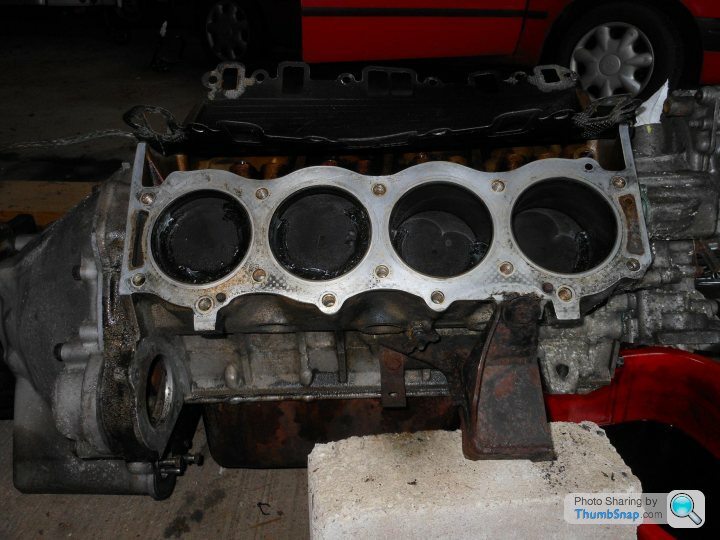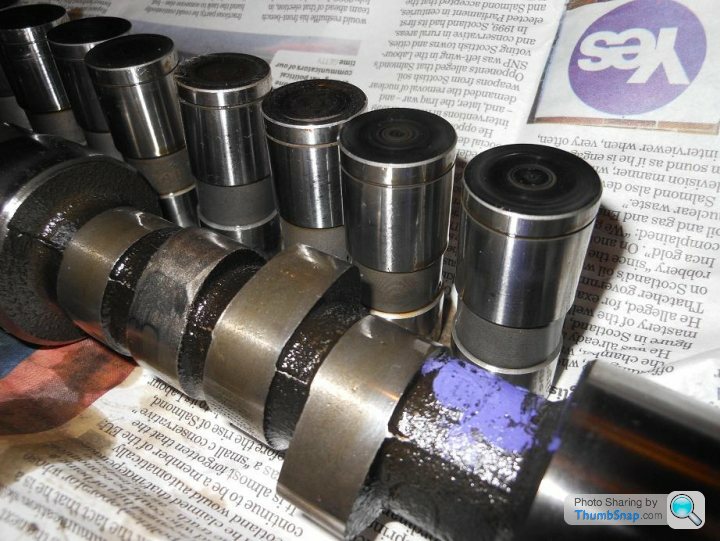Compression test values
Discussion
I'm playing with my 350i at the moment and checked the compressions. Engine cold, open throttle.
On the left hand bank (in PSI)
182,182,179,182 front of car to rear - so far so good.
Right hand bank
189,188,173,190.
Composite gaskets with 0.7mm skimmed off the heads.
I don't like the disparity between left and right; I especially dont like the 173 amongst the 190ish on the right hand bank. However all the values seem very high to me.
Any comments, should I pull the heads off and investigate?
On the left hand bank (in PSI)
182,182,179,182 front of car to rear - so far so good.
Right hand bank
189,188,173,190.
Composite gaskets with 0.7mm skimmed off the heads.
I don't like the disparity between left and right; I especially dont like the 173 amongst the 190ish on the right hand bank. However all the values seem very high to me.
Any comments, should I pull the heads off and investigate?
Thanks for all the comments, it helps the old grey matter move along...
Plugs are all sooty due to ECU/AFM/wiring shananigans so no clues there, certainly no steam cleaning;
There's no water passages close to the 'low' cylinder so I don't think it's related to cooling system issues (although if one pot is dodgy maybe another is too?);
Engine was running OK when the ECU/AFM/wiring was playing ball (I think the compressions are a long term issue and it has run quite well relatively recently);
Compression testing was done without fueling (wiring's been removed).
Unfortunately I pulled the top of the engine apart for the megasquirt exercise before checking the compressions, so I can't now run the engine and do a hot test. When I had the heads off last time the bores were pretty much perfect and I've got no reason to think that it's had a reason to crack/break the rings since. All the valves were ground/bedded in at that time so I think they're OK too.
I'm still a bit curious as to the 180psi ish readings on a cold engine; it does seem pretty high but I guess the gauge calibration may have something to do with it. I'm thinking it's the variation that's the problem rather than the actual values; I did try several times and got very consistent readings on each cylinder.
I think I'll have to bite the bullet and pull the head(s) off to investigate. My suspicion is that the head gasket is dodgy; I fitted composites from Ri**ers and I wasn't particularly happy with them at the time. I suspect I have two problems, the 170 psi pot is blowing into the valley area and one of the outermost water passages is giving the cooling system issues. Does anyone have experience of Felpro gaskets or any other make/suppliers?
Plugs are all sooty due to ECU/AFM/wiring shananigans so no clues there, certainly no steam cleaning;
There's no water passages close to the 'low' cylinder so I don't think it's related to cooling system issues (although if one pot is dodgy maybe another is too?);
Engine was running OK when the ECU/AFM/wiring was playing ball (I think the compressions are a long term issue and it has run quite well relatively recently);
Compression testing was done without fueling (wiring's been removed).
Unfortunately I pulled the top of the engine apart for the megasquirt exercise before checking the compressions, so I can't now run the engine and do a hot test. When I had the heads off last time the bores were pretty much perfect and I've got no reason to think that it's had a reason to crack/break the rings since. All the valves were ground/bedded in at that time so I think they're OK too.
I'm still a bit curious as to the 180psi ish readings on a cold engine; it does seem pretty high but I guess the gauge calibration may have something to do with it. I'm thinking it's the variation that's the problem rather than the actual values; I did try several times and got very consistent readings on each cylinder.
I think I'll have to bite the bullet and pull the head(s) off to investigate. My suspicion is that the head gasket is dodgy; I fitted composites from Ri**ers and I wasn't particularly happy with them at the time. I suspect I have two problems, the 170 psi pot is blowing into the valley area and one of the outermost water passages is giving the cooling system issues. Does anyone have experience of Felpro gaskets or any other make/suppliers?
Head gaskets confirmed as dodgy, with corrosion on the head/block faces caused by coolant leakage. There was also a load of carbon deposits on the head dowel nearest the dodgy cylinder indicating combustion gasses leaking out, I assume that was the reason for the low compression. I have Felpro (Federal Mogul) gaskets to go back on, I hope they do a better job!


I'm tempted by the ARP studs... However this is a standard 3.5L engine so I think it should be OK with bolts; I've spent some time cleaning and checking the bolts/washers and they look OK to me. I'm planning on using the ARP studs on the SEAC engine though... I have two V8s in pieces ATM!
I'm not unduly surprised about the cam. It was one of the freely available aftermarket cams at about £120 for the cam and followers; moral of the story is that you gets what you pays for. OE Land Rover cams are £400+ as are Piper/Kent etc alternatives (with the followers). Real Steel offer cheaper ones but you don't know the quality until you try them, I might try that at some point but I'm not holding my breath! I've put back in a 'high compression' cam from Rimmers which I don't think was available a couple of years ago (and it does look better quality); I didn't want to put an expensive cam in as after I've fitted megasquirt I can't guarantee a quick 'fire up and run at 2000rpm for 10 mins' scenario. I'll probably change the cam again later... or stuff in the 420 surrogate engine from the SEAC! It's a good job that I like messing with engines/cars.
I took the upmost care fitting the cam 2 years ago; as clean as possible, new followers, cam lube (ZDDP) galore, quick fire up and run in at 2000rpm for 10 mins. 20/50 oil changed regularly (halfords classic then valvoline later), few short runs (20 miles to work...), idles at 1000+ rpm. There's only so much you can do with suspect hardware! I'd done less than 5000 miles but the engine still felt pretty good, I think the RV8 is a pretty tolerant lump.
It's on the 'lessons learned the hard way' list.
I took the upmost care fitting the cam 2 years ago; as clean as possible, new followers, cam lube (ZDDP) galore, quick fire up and run in at 2000rpm for 10 mins. 20/50 oil changed regularly (halfords classic then valvoline later), few short runs (20 miles to work...), idles at 1000+ rpm. There's only so much you can do with suspect hardware! I'd done less than 5000 miles but the engine still felt pretty good, I think the RV8 is a pretty tolerant lump.
It's on the 'lessons learned the hard way' list.
I generally drive off as soon as I can, and take it gently for a while.
I wondered about a 3.9 cam, I'm not sure what the differences are. I did think that the 3.9 was an off roader cam so would be tuned for low end torque rather than top end power but that may not be a bad thing anyway!
I wondered about a 3.9 cam, I'm not sure what the differences are. I did think that the 3.9 was an off roader cam so would be tuned for low end torque rather than top end power but that may not be a bad thing anyway!
Hi Adam,
The casting flash/mismatch is pretty bad but I don't think it was the cause of the failure - I spotted it before I fitted the cam and ground it away so that it was below the surface that the cam followers run on. The follower surface is flat so this flash would only be a problem if/when the follower wears to a dish; by which time you'd be through the case hardening and into rapid wear anyway. However it didn't give me a good feeling about the quality of the cam!
I've been known to bin new parts when I've received them due to poor quality (suspension bushes, ball joints and brake discs spring to mind - safety critical stuff) but I thought at the price this camshaft was worth a punt.
Good call about the cam followers though, it could well be the followers rather than the cam but I suspect it's actually both. I'm not sure about how the followers are hardened, but it could also be the surface finish or the tolerances on flatness etc. on either the cam or the followers.
The casting flash/mismatch is pretty bad but I don't think it was the cause of the failure - I spotted it before I fitted the cam and ground it away so that it was below the surface that the cam followers run on. The follower surface is flat so this flash would only be a problem if/when the follower wears to a dish; by which time you'd be through the case hardening and into rapid wear anyway. However it didn't give me a good feeling about the quality of the cam!
I've been known to bin new parts when I've received them due to poor quality (suspension bushes, ball joints and brake discs spring to mind - safety critical stuff) but I thought at the price this camshaft was worth a punt.
Good call about the cam followers though, it could well be the followers rather than the cam but I suspect it's actually both. I'm not sure about how the followers are hardened, but it could also be the surface finish or the tolerances on flatness etc. on either the cam or the followers.
Gassing Station | Wedges | Top of Page | What's New | My Stuff




